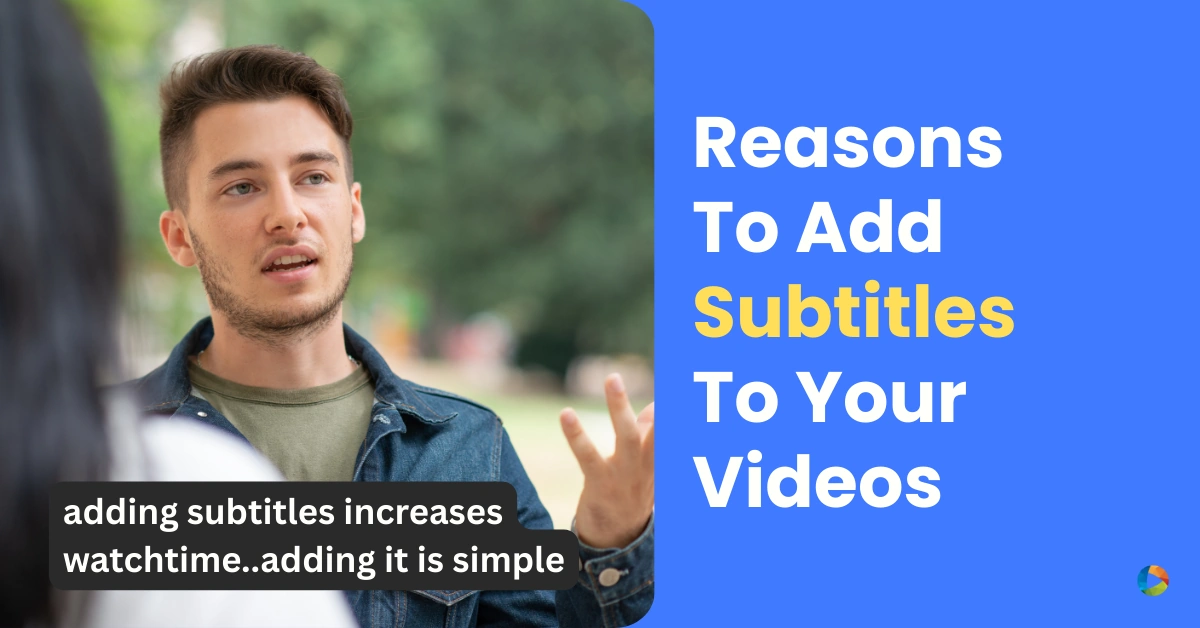5 Compelling Reasons To Add Subtitles To Your Videos
Last Updated on May 27, 2025 by Anjana Devi
Research has proven time after time the power of visual memory. Humans can process and store information if it is visually appealing as it is easy to recall and remember. As per WYZowl, 94% of marketers believe that using video content has helped the user understand their products/services better.
That said, how often have you found that your video (with great content, optimized titles and description) – even after being extensively promoted did not perform as well as you wanted it to. Chances are, you’ve overlooked an important aspect: Subtitles.
Subtitles add more context to the video content. It helps viewers to understand the messaging of videos more easily. A subtitle is a great way to create an image and video format, especially for long-form video content.
Research proves that viewers who use subtitles are more likely to complete watching a video and the number viewership is also high.
Tubular Insights observed that subtitles increase video viewing by 40% and where subtitles appeared, 80% more people watched the entire video.
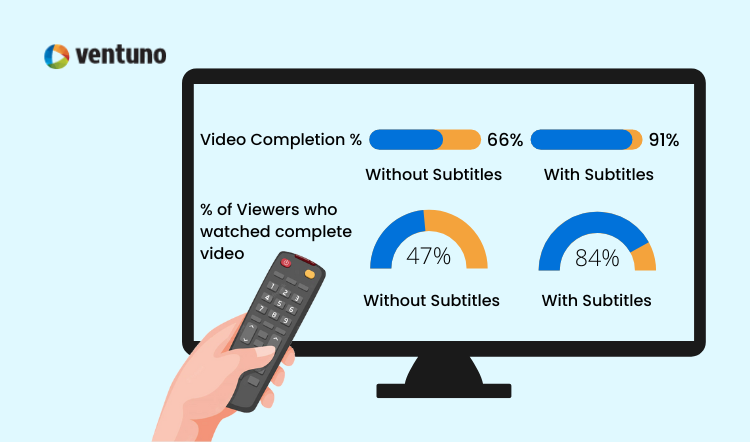
In this article, we give you a holistic view of what are subtitles and captions, why are they needed and what are the advantages of having them along with your video content.
Subtitles & Captions – What Are They?
While it may sound very the same and at times, these terms are used interchangeably, subtitles and captions do have certain differences.
Subtitles are the spoken word of the person that is overlaid on a video. When a person speaks in the video, the text of those words is considered subtitles. Subtitles help in clarifying what is being said as certain words could be misheard by the viewers.
Subtitles play a great role in breaking down the language and accent barrier. A video made in the local language can be translated and have subtitles developed in the most commonly spoken language such as English to gain a wider reach.
Captions or rather closed captions are the textual representation of sound effects, identification of the speaker and other non-speech elements.
Closed captions are helpful for people who cannot hear or have a hard time hearing as it helps them to provide audio context along with the spoken word.
Captions communicate all types of audio information to viewers whereas subtitles communicate only the spoken word of the person in the video.
Both the subtitles and captions are synchronized with the video so that they play along with the video and viewers can enjoy the video they are consuming without missing out on any crucial information or audio element of the video.
The most important purpose that subtitles and captions fulfill is that the video is engaging and accessible for viewers who may have tuned out of the video or are unable to understand the language of the video.
Subtitle Best Practices
Here are some of the best practices that can be followed while creating subtitles and captions for your video content.
Timing
Timing is very important when it comes to creating subtitles and captions. Every spoken word, sound effect, and any other audio element needs to enter and exit just at the right time from the video.
Even in a millisecond here and there and it can ruin the entire experience for viewers and will leave the viewers disappointed. The placement of every text needs to be cross-checked multiple times.
Choosing the Right Words
It is critical that when dialogues are spoken, the exact words are used instead of similar words as they can lose their meaning. The words of the subtitle should be exactly the same as the spoken word. As for sound effects and other audio elements for captions, words that represent the scenario the closest should be used.
Readability
You need to take into consideration the font type, font size, and color in which the subtitles will appear as it may impact the readability of it when the text appears. The best practice is to have 12-15 characters per second of the video but this may vary as per the dialogues and sound effects in a particular scene.
Language
Especially when the English content is being shown to a non-English audience or vice versa, language plays a key role in subtitles. Words need to be contextually localized and then written in the local language for English content videos as not everyone will have the ability to understand the English language.
Similarly, when the content is non-English audio-wise, it needs to be carefully translated into the English language.
5 Benefits of Adding Captions or Subtitles
Captions or subtitles come with many benefits. Understanding the content, not getting misheard on any scene or part of the video. We will deep dive into each benefit and understand its importance.
1. Accessibility
One of the biggest advantages that subtitles or captions offer is that it makes video content easy to consume for all. People with hearing difficulties can also enjoy video content without losing much interest in it.
Say there is a scene where a thunderstorm happens and or flood happens. These scenes can be explained with captions like “THUNDERSTORM INTENSIFIES” or “FLOOD RUSHES”.
This provides a better experience for all kinds of viewers and helps to expand the richness of the video content.
Subtitles and captions also make content accessible at different locations. Be it an office or library, you can watch a video with subtitles on and audio off and still understand the context. As a result of subtitles, video content is accessible at any time, anywhere, and without making you lose the context.

2. User Experience
Subtitles or captions enhance the experiences that video content provides. According to Digiday, 85% of the videos on Facebook are being watched without sound and just with the help of subtitles and captions.

Adding on to what was mentioned above in the accessibility point, the user experience derived through subtitles and captions allows viewers to watch content from any public space or workplace without the need of having sound.
News outlets such as NowThis and Brut have understood the importance of subtitles and most of their videos contain text over the video with certain words highlighted. This captures the attention of viewers, irrespective of where they are, and can still consume video content.
Mobile is the common device to watch video content. Be it Instagram, TikTok, YouTube, or Facebook, mobile users dominate over laptops or PCs when it comes to consuming video content. Therefore, videos are now designed with a mobile-first approach, making it the main reason video consumption has increased massively over the years thanks to its mobile-focused designs.
3. Better Reach
Subtitles and captions also help in increasing the reach of the video content. It helps to break the language barrier and connects people from around the world, irrespective of in which language the original content was made.
The recent widespread popularity of OTT platforms has enabled international shows and movies (not originally made in English) to gain massive traction. This itself is proof of the fact that subtitles and captions play a highly important role in getting a better and wider reach for video content.
Some of the most common examples of shows that were made in local languages but became global favorites are – South Korean movies and shows like Parasite, Squid Games, German shows like Dark, and Spanish-Mexican shows like Narcos and Money Heist. Their success is attributed to subtitles in the English language.
Subtitles and captions in video content allow you to engage with an audience that you wouldn’t have thought that you would be able to reach in the first place. Apart from that, it helps to cross borders, cultures, and barriers and unites the world in a completely unique way.

4. Content Repurposing
The most important aspect of content is words and words can take up any form depending on how you want to interact and engage with your audience.
A transcript of a video can become a blog, a podcast, an email, infographics, social media posts, and so on. Depending on the platform and where you want to reach your audience, the content can take any shape or form.
Even subtitles and captions are words, once jotted down, can be easily converted into several formats. They can be used as images, gifs, infographics, short reels/TikTok videos, and content is not only repurposed but also redistributed on various different platforms.
A trend we’re commonly observing is two or four stills from a popular video are combined together and put on social media as images. Stills shared this way are aimed at garnering the audience’s attention.
5. The Video SEO Benefit
Subtitles can improve your video’s SEO ranking. The transcribed text can be embedded with the multimedia file. This helps in searchability for viewers and they can find video content based on the textual content of the video they want to watch.
The result is increased organic reach of the video to a wider audience. Searchability and discoverability can be done organically by users if the multimedia files have closed captions embedded on the backend.
💡 Tip
If you localize your subtitles in languages other than English, your video will also rank for keywords in other languages. You will be able to target local SEO keywords, helping you reach more native viewers.
How Do Subtitles & Captions Work?
Broadly speaking, there are two types of subtitles: SubRip Subtitle or SRT and Web Video Text Tracks or VTT.
SRT usually consists of timestamp, sequence, caption text and so on and can be created on notepad and saved in .srt format. YouTube, Vimeo, Facebook, Twitter and LinkedIn all support .srt format.
VTT was created keeping in mind the functionalities of HTML5, VVT format is much more, say, dynamic in nature than compared to SRT. Font alignment and font styling options are provided in VTT format and are much more advanced compared to SRT format.
Here are some key differences between SRT & VVT:
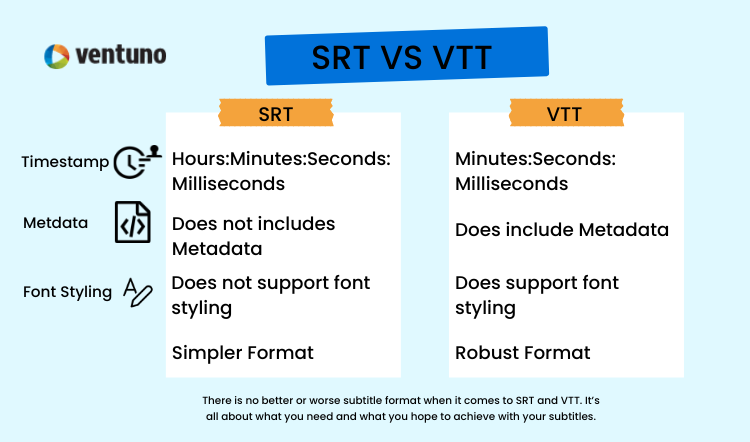
1. Go to the content section of the left menu, select Organize > Video Library.
2. Click Add Subtitles next to the video to which you want to add your subtitles.
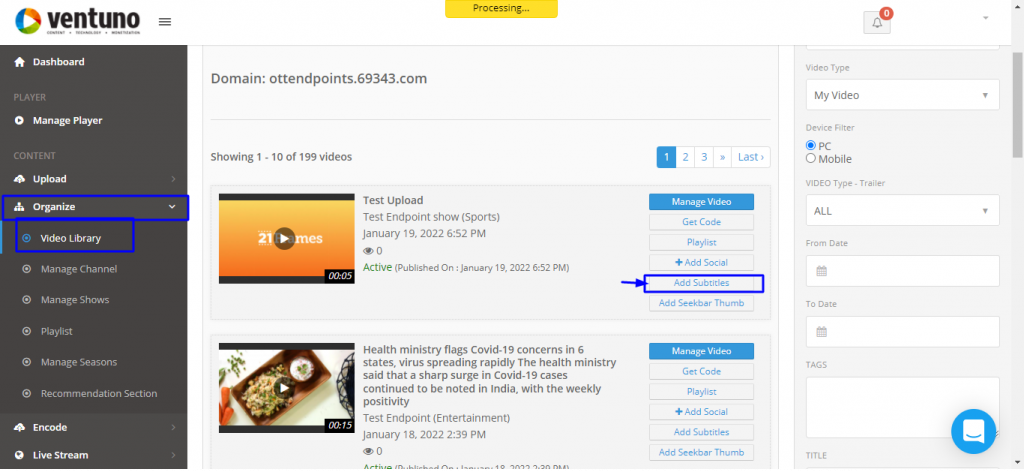
3. Click on the dropdown ‘Select Language’ to select the language of the subtitle., and click ‘Choose File’ to upload the subtitle file.
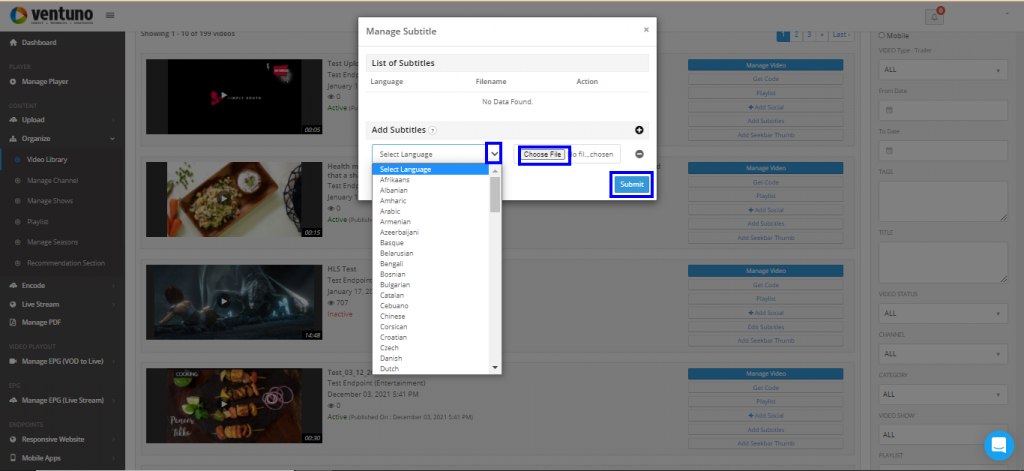
4. Click Submit to complete the process.
5. To add a subtitle in another language, repeat steps 2 to 4.
6. You can also delete the added subtitles (in case you uploaded the wrong file).
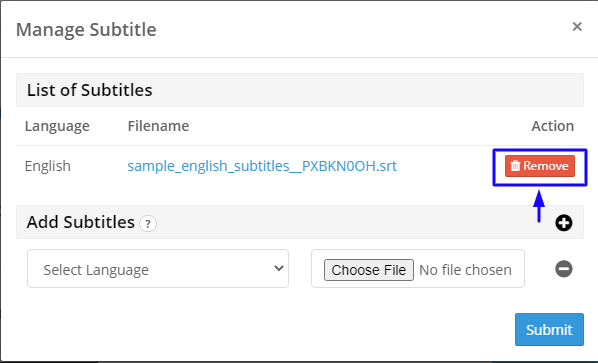
Final Thoughts
Adding subtitles and captions to video content may seem like a lot of work. But exposure to the wider audience, better clarity, and accessibility are some of the many benefits of adding video subtitles and captions.
Ventuno can support subtitles and captions in multiple formats and languages. With a few steps, you insert subtitles in SRT as well as VVT format.
If you would like to know more about the platform, click here and feel free to schedule a demo with us.
Looking to launch your streaming app?

